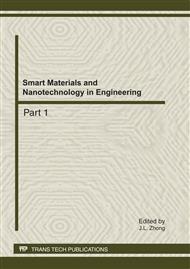[1]
W.L. Xu, J. Bronlund and J. Kieser, A robotic model of human masticatory system for reproducing chewing behaviours, IEEE Robotics Automation Mag., vol. 12, no. 2, p.90–98, December (2005).
DOI: 10.1109/mra.2005.1458330
Google Scholar
[2]
J. W. Kwak, H. J. Chi, K. M. Jung and J. C. Koo, A Face Robot Actuated With Artificial Muscle Based on Dielectric Elastomer, Journal of Mechanical Science and Technology, vol. 19, no. 2, pp.578-588, (2005).
DOI: 10.1007/bf02916180
Google Scholar
[3]
M. Cong, Z. B. Chang. Y. Du, and W. L. Xu, Modeling and simulation of masticatory robot, In Proceedings of the 2010 IEEE-RAS International Conference on Intelligent and Dependable Humanoid Robots, Nashville, TN, USA November, 2010, unpublished.
DOI: 10.1109/ichr.2010.5686300
Google Scholar
[4]
H. Takanobu, K. Ohtsuki, A. Takanishi, M. Ohnishi, and A. Okino, Jaw training robot and its clinical results, In Proceedings of the 2003 IEEE/ASME International Conference on Advanced Intelligent Mechatronics (AIM 2003), 2003, p.932–937.
DOI: 10.1109/aim.2003.1225467
Google Scholar
[5]
B. Lin, Chew on this, UBC Reports, Vancouver, BC, Canada, 2005, p.1–8.
Google Scholar
[6]
T. Hayashi, S. Kato, S. Yamada, S. Nakajima, Y. Yamada, and H. Kobayashi, A physiological control of chewing-like jaw movement for robotized jaw simulator JSN/2A, In Proceedings of the 22nd Annual EMBS International Conference, Chicago, USA, p.730–731, July (2000).
DOI: 10.1109/iembs.2000.900851
Google Scholar
[7]
M.C. Bourne, Relationship between rheology and food texture, in: J. Welti-Chanes, G.V. Barbosa-Canovas, J.M. Aguilera (Eds. ), Engineering and Food for the 21st Century, CRC Press, LLC, 2002, p.395–408.
DOI: 10.1201/9781420010169
Google Scholar
[8]
J. Nakajima, et al, Masticatory mandibular movements for different food texture related to onomatopoetic words, Med. Dent. Sci., vol. 48, p.121–129, (2001).
Google Scholar
[9]
H. Takanobu and A. Takanishi, Dental robotics and human model, , In Proceedings of the 1st International IEEE EMBS Conference on Neural Engineering, Capri Island, p.671–674, March (2003).
DOI: 10.1109/cne.2003.1196918
Google Scholar
[10]
Richard Wier Katzberg, Temporomandibular Joint Imaging, Anesth Prog, vol. 37, pp.121-126, (1990).
Google Scholar
[11]
J. H. Koolstra, T. M. van, and Eijden, A method to predict muscle control in the kinematically and mechanically indeterminate human masticatory system, J. Biomech, vol. 34, p.1179–1188, (2001).
DOI: 10.1016/s0021-9290(01)00053-7
Google Scholar
[12]
Kazem Alemzadeh and Daniel Raabe. Prototyping Artificial Jaws for the Bristol Dento-Munch Robo-Simulator, In Proceedings of the 29th Annual International Conference of the IEEE EMBS CitéInternationale, Lyon, France, pp.1453-1456, (2007).
DOI: 10.1109/iembs.2007.4352574
Google Scholar
[13]
T. M. G. J. van Eijden, J. A. M. Korfage, and P. Brugman. Architecture of the human jaw-closing and jaw-opening muscles, Anat. Rec, vol. 248, no. 3, p.464–474, (1997).
DOI: 10.1002/(sici)1097-0185(199707)248:3<464::aid-ar20>3.0.co;2-m
Google Scholar
[14]
Z. Huang, Y. S. Huang, and T. S. Zhao, Advanced Spatial Mechanism, Higher Education Press, 2006, p.115–127.
Google Scholar


